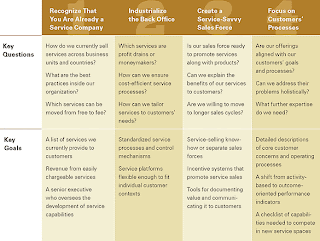In the May issue of Harvard Business review, an article by Reinartz et al. puts forth the notion that firms frequently believe that adding value in the form of services will provide a competitive advantage after their products start to become commodities. When the strategy works, the payoffs are impressive, and a company may even discover that its new service business makes more money than its products. But for every success story, anecdotal cautionary tales remind us that most companies will most likely struggle to turn a profit from their service businesses.
Companies unsuccessful at developing service profitability have tried to transform themselves too quickly. Successful firms begin slowly, identifying and charging for simple services they already perform and using those to build enthusiasm for adding more-complex ones.
They then standardize their delivery processes to be as efficient as possible. As their services become more complex, they ensure that their sales force capabilities keep pace.
Finally, management switches its focus from the company’s processes and structures to the nature of customers’ problems, the opportunities that customers’ processes afford for inserting new services, and the new capabilities needed to deliver those services. In other words, they take partnering to the next level (See the exhibit below –click for larger view)
